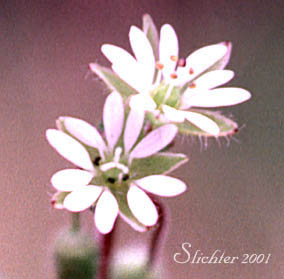

 The photo
at right illustrates the longitudinal lines of hairs lining the stems, petioles
and pedicels.
The photo
at right illustrates the longitudinal lines of hairs lining the stems, petioles
and pedicels.
Chickweed is an annual weed, or in mild, moist climates becomes longer lived and even spreads during the winter. It is a low growing species with spreading stems up to 50 cm long which root at the leaf nodes. The herbage has lines of hairs which run the length of the stems, leaf petioles and flower pedicels. The leaves range from ovate to ovate-elliptic in shape and 10-25 mm long. The petioles on the lower leaves are nearly as long as the blades while the upper leaves may be sessile.
The inflorescence consists of leafy-bracteate cymes found at the terminus of the stem and in the leaf axils. The cymes consist of 3-7 white flowers. The 5 petals are shorter than the sepals and are deeply incised nearly to their base, giving the appearance of flowers with 10 narrow petals. The 5 sepals are about 5 mm long and are oblong-lanceolate in shape with obtuse to acute tips.
Chickweed is a weedy species of disturbed fields, roadsides, waste areas and yards.
Native to Eurasia, chickweed is now found over much of North America. In the Pacific Northwest, it is largely found west of the Cascade Mts.